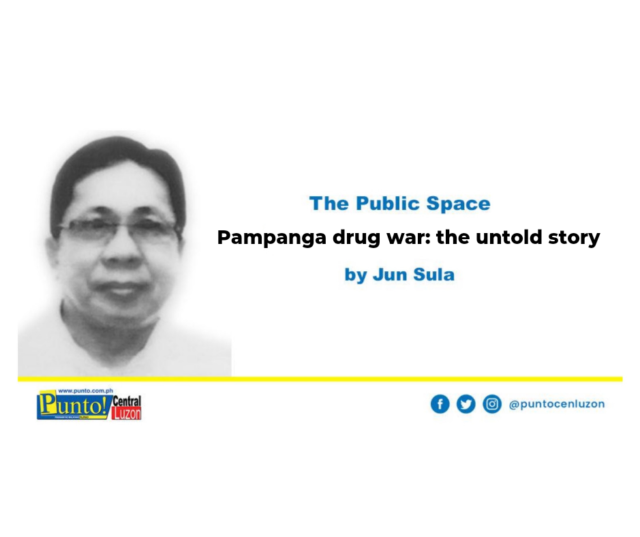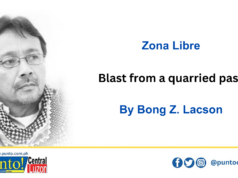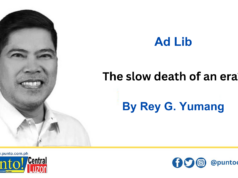PRESIDENT Duterte’s war on drugs has claimed thousands of lives — 6,000 more or less the government says, as high as 20,000, the human rights group counters — the International Criminal Court (ICC) is halfway into its direction to ascertain that crimes against humanity were, indeed, committed in the deadly war.
That’s one side of the story. The other side is, well, less bloodier narratives than it is made to appear on the national level. In this respect, it is now known that,at least, three local government units ,or their police units, to be exact, didn’t follow the national template of large-scale deaths and violence.
One of them is Pampanga. To be more specific, former Governor and now Vice Governor Lilia Pineda, more aptly called ‘Nanay, who ruled the province from 2010 to 2019. And she has played the role to the hilt. The joke goes around that she is the best engineer when she is talking to public works people and knows better when she speaks before public health experts.
Arguably, as the saying goes, mother knows best. Even when it came to how police did their jobs in fighting the war on drugs.
In a research paper written by Peter Kreuzer titled ‘Governors and Mayors of the Philippines: Resistance to and Support to Duterte’s Deadly War on Drugs, ‘Nanay’ was lumped with the Gatchalian brothers of Valenzuela City and Davao City Mayor Sara Duterte Carpio as the three active local chief executives who mitigated the so-called bloody national campaign.
At the core of Pineda’s leadership person, Kreuzer wrote, is a caring patron, the ‘Nanay’ image. Not that she was wanting in toughness. In fact, Kreuzer noted that one core segment of her caring image has been a tough anti-drug crime stance and strong focus on law and order.
“While she shared the vision of the later Duterte campaign, her strategy was different,” Kreuzer noted.
The first difference Kreuzer saw was that ‘Nanay’ adopted citizen security as part of her policy agenda. She did this by strengthening the Barangay Anti-Drug Council (BADAC) to make the LGUs effective partners in crime prevention and keeping peace and order. She is also credited for embedding the provincial police in a network of social control, virtually creating a safety net against potential police abuse. She also led at the front by spearheading various anti-drug summits in the province.
In ‘Reinventing Government’, David Osborne and Ted Gaebler stressed the wisdom of empowering the citizenry as partners in crime prevention and other tasks . “We let the police,the doctors, the teachers and socials workers have all the control while the people they are serving have none,” the book said.
The governor understood, by heart or experience, the importance of people’s control over their own problems. She made sure the people were part of the solution. Empowerment by a different language.
As critical was her messaging. She was also clear about her aim: to avoid the killing of fellow Kapampangans. To avoid fatal violence, Kreuzer wrote, she asked drug suspects to surrender, saying nobody will be killed in Pampanga.
Governing like a mother true to both form and substance, Pineda was quoted as saying she didn’t want any Kapampangan killed because of drugs. She believed in giving her erring kabalens a second chance. On top of that, she was willing to reach out to parents and families of the suspects to avoid bloodshed.
“I am the mother of all Kapampangans,” Kreuser wrote her as saying, “ tell the surrenderees I cannot help them if they keep going back to their old habit”.
Apparently, her call was heeded. For three and a half years from July 2016 to December 2019, only six cases were reported. This was the lowest by Philippine standard. Also, it was noted that vigilantes played no role during this time. The ‘Nanay’effect?
Two major strategies worked to complement ‘Nanay’s message: 1) strengthening social control in the communities and 2)reducing the autonomy of the police. Highlighting the latter was when ‘Nanay’ reportedly asked the provincial and municipal police directors not to knock on the suspects’ doors, the infamous ‘tokhang’ approach, but let the village chiefs take that duty. That essentially eliminated the risk of any untoward, let alone bloody, encounter. In this case, employing familiarity with people and their circumstances proved an effective tool.
In addition, ‘Nanay promised educational and livelihood assistance to drug offenders, even providing job options to those who are qualified.
Kreuzer concluded: “In 2016, it allowed provincial governor Lilia Pineda to make use of pre-existing networks and established practices in order to broaden control over police interventions in the war in drugs. Thus, police use of deadly force was left under control as well as vigilante killings.”
In the ongoing debate over the possible accountabilities of people involved the deadly war against drug offenders by the Duterte Administration, some who knew their involvement may have reason to worry about the possibility, however remote, of arrest.
Fortunate are those who came up with their own working plans and strategies to fight the war in a way that also saved many peoples’ lives in the process. They can sleep well even if an ICC probe is finally allowed to take its course.
In Pampanga’s case, the motherhood concept of governance has proved its worth, especially in as dangerous time as the war on drugs. It was a good thing ‘Nanay’ was governor at the time. Things would have been different. She knew who called the shots, or should.





